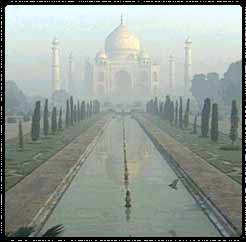Agra the former capital of Hindustan, is a city on the banks of
the river Yamuna in the northern state ofUttar Pradesh, India. It is 363
kilometres (226 mi) west of the state capital, Lucknow, and 200 kilometres
(124 mi) south of the national capital New Delhi. With a population of
1,686,976 (2010 est.), it is one of the most populous cities in Uttar Pradesh and the 19th most populous inIndia. Agra can also refer to the administrative district that has its headquarters in Agra
city.
The city
is mentioned in the epic Mahābhārata,
where it was called Agrevaṇa ("the border of the forest").Legend ascribes the founding of the
city to Raja Badal Singh, a
Sikarwar Rajput king (c. 1475), whose fort, Badalgarh,
stood on or near the site of the present fort. However, the 11th century
Persian poet Mas'ūd Sa'd Salmān writes of a desperate assault on the
fortress of Agra, then held by the Shāhī King Jayapala,
by SultanMahmud of Ghazni. Sultan Sikandar Lodī was the first to move his capital from Delhi to Agra in 1506. He died in 1517 and
his son, Ibrāhīm Lodī, remained
in power there for nine more years, finally being defeated at the Battle of Panipat in 1526.Between 1540 and 1556, Afghans,
beginning with Sher Shah Suri,
and Hindu King Hem Chandra
Vikramaditya (also called Hemu), ruled the area. It achieved
fame as the capital of the Mughal
Empire from 1556 to 1658. It is a
major tourist destination because of its many splendid Mughal-era buildings,
most notably the Tāj Mahal, Agra Fort and Fatehpūr
Sikrī, all three of which are UNESCO World Heritage Sites.



